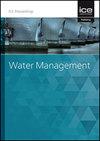Towards safer, more sustainable debris and security screens
IF 0.9
4区 工程技术
Q3 ENGINEERING, CIVIL
Proceedings of the Institution of Civil Engineers-Water Management
Pub Date : 2023-05-31
DOI:10.1680/jwama.22.00031
引用次数: 0
Abstract
The UK has over 35,000 primary, debris and security screens, intended to prevent internal blockage of culverts by debris and/or entry to a hazardous culvert. Historically some screens were constructed with insufficient justification, insufficient area or poor detailing, leading to increased flood risk and unnecessary safety risks to operatives, especially during high river levels. In 2019, CIRIA's Culvert, screen and outfall manual (C786) replaced the Environment Agency Trash and security screen guide and CIRIA Culvert design and operation manual. The manual encourages assessment of the ongoing need for screens and where they cannot be removed, to take a systems approach that considers the wider watercourse and catchment. This paper presents findings from early experience of using the manual on an Environment Agency programme to assess the continuing need for 92 screens in England. Early indications are that avoiding unnecessary screens and removing or modifying existing screens can improve safety, help natural sediment and debris movement along a watercourse, reduce operational expenditure, and support the net zero carbon target and UN SDG 13 (Climate action). It is recognized that every screen is unique and not every situation is covered by guidance. A novel design that reduces flood and/or safety risk can be justified with documented rational analysis.朝着更安全、更可持续的碎片和安全屏幕发展
英国有超过35000个主要、碎片和安全屏幕,旨在防止碎片和/或进入危险的涵洞对涵洞的内部堵塞。从历史上看,一些筛网的建造理由不足,面积不足或细节不佳,导致洪水风险增加,给操作人员带来不必要的安全风险,特别是在高水位期间。2019年,CIRIA的涵洞,屏幕和排水管手册(C786)取代了环境署垃圾和安全屏幕指南和CIRIA涵洞设计和操作手册。该手册鼓励评估目前对屏障的需求,以及在无法移除屏障的情况下,采取考虑到更广泛的水道和集水区的系统方法。本文介绍了在英国环境署项目中使用手册评估对92个屏幕的持续需求的早期经验。早期迹象表明,避免不必要的筛网,拆除或修改现有的筛网可以提高安全性,帮助自然沉积物和碎屑沿着水道移动,减少运营支出,并支持净零碳目标和联合国可持续发展目标13(气候行动)。人们认识到,每一个屏幕都是独特的,并不是每一种情况都适用指导。一个新颖的设计,可以减少洪水和/或安全风险,可以证明与文件的理性分析。
本文章由计算机程序翻译,如有差异,请以英文原文为准。
求助全文
约1分钟内获得全文
求助全文
来源期刊
CiteScore
2.10
自引率
0.00%
发文量
28
审稿时长
6-12 weeks
期刊介绍:
Water Management publishes papers on all aspects of water treatment, water supply, river, wetland and catchment management, inland waterways and urban regeneration.
Topics covered: applied fluid dynamics and water (including supply, treatment and sewerage) and river engineering; together with the increasingly important fields of wetland and catchment management, groundwater and contaminated land, waterfront development and urban regeneration. The scope also covers hydroinformatics tools, risk and uncertainty methods, as well as environmental, social and economic issues relating to sustainable development.

 求助内容:
求助内容: 应助结果提醒方式:
应助结果提醒方式:


